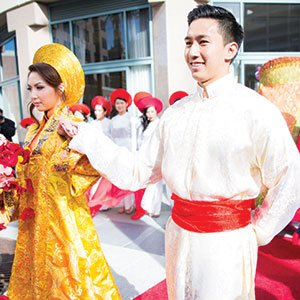Features & Columns
Silicon Alleys: Ao Dai Festival Pays Homage to Traditional Vietnamese Gown
 The annual Ao Dai Festival takes place this weekend at the San Jose Museum of Art. Photo by Kevin Nguyen
The annual Ao Dai Festival takes place this weekend at the San Jose Museum of Art. Photo by Kevin NguyenBy now, many are familiar with an ao dai, the traditional Vietnamese gown, a colorful garment worn mostly by women and usually over trousers. This stylish dress has been the muse for many poets and at least one newspaper columnist for years.
However, thanks to the efforts of Jenny Do, a longtime San Jose attorney and Viet arts leader, the dress is now elevated far beyond clothing or fashion. It symbolizes multiple dimensions of female empowerment, liberation, struggle, pride and obstacles overcome.
So much, that the fifth Ao Dai Festival erupts this Saturday, including several new components. First, a procession of at least 200 people wearing the ao dai will begin at City Hall and conclude at the San Jose Museum of Art, where a grand-scale theatrical ceremony will take place in the Circle of Palms. This part is free for everyone. Then the formal ticketed segment occurs inside the Fairmont, where an elaborate experience of music, dance and fashion will unfold for the rest of the evening.
Vietnamese Americans constitute somewhere around 12 percent of San Jose's population these days, yet their voices, particularly those of the women, don't often resonate in the mainstream. Now Jenny Do has elevated the ao dai to a cultural movement.
"It's an icon, it's an identity, especially for women," says Do. "In the age of modernity, the ao dai remains graceful, feminine, and it shows strength at the same time. For Vietnamese women, we always emphasize inner beauty and the four virtues, and the ao dai seems to indicate that."
The Ao Dai Festival defies categorization. It must be experienced to be understood. In my view, it's far beyond the more standardized ethnic festivals one tends to see around town these days. Plus, what's different this year is that the total value of the dresses will tip the scales at more than $80,000. Some of them will be ornately woven with 24-carat gold elements. When the colorful ao dai procession takes place, people of all ages will waltz down Santa Clara Street in grand fashion. The streets will not be blocked off. Instead, the procession will unfold on the sidewalk with a police escort.
"Elders in their wheelchairs will be wheeled in the ao dai, the children, men, women, are all going to be wearing the ao dai," Do says."People asked all sorts of questions: 'I'm in a wheelchair, can I still participate, I can't really walk, can I join at one point and then drive?' These were some of the questions that came in. People seem to be very proud to wear the ao dai. And that's a big plus, a big positive for us."
As the procession makes it way toward the art museum, it will stop at Second Street to pick up a giant carriage which carries the "Mother of Vietnam" all the way to the Museum of Art. Once there, ao dai from each of Vietnam's three main regions will be presented to the mother for a huge celebration. The theme of this year's festival focuses on the confluence of rivers in Vietnam, which delineate the three subregions carved out by the French, so when attendees enter the Fairmont, they will experience an environment showcasing each of the three regions with artifacts, props, models and various accoutrements. Then in the ballroom, dance, drums, performances related to each region will unfold. In the end, all three regions come together via music, dance and fashion.
The ao dai dress itself has gone through quite a provocative evolution over the decades, with various adjustments to the primary form, its patterns and style. What used to be a more formal and baggy type of gown gradually became tighter and more suggestive, but without being tacky or risque. Slits were added enabling women to ride bikes. Vietnamese men started writing poetry inspired by the various ways in which the modern styles revealed tiny glimpses of flesh. In other cases, modern designers are doing away with older styles that used to cover the neck entirely.
"The development of the ao dai over the years [has paralleled that of] feminism in Vietnam, the demand that we should be free to showcase our bodies without vulgarity, without disrespecting ourselves," Do says.


